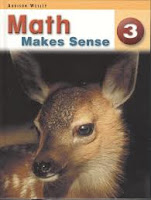Prior to taking this course, 3940 - Teaching
Mathematics in the Primary/Elementary Classroom, I perceived Mathematics as an intimidating
subject area, one that would be extremely difficult to teach because of the
many negative connotations that are often associated with it. I was nervous to
teach mathematics, for I was not sure how to make mathematics engaging for students
at the primary/ elementary level. However, this course has taught me that
mathematics does not have to be an intimidating subject area, but rather a
subject area that students can be excited about and look forward to. I believe
that this course has prepared me for teaching mathematics in the future, for it
has provided me with a whole new perspective concerning the teaching of mathematics.
This course has shown me that mathematics can be made fun through an
interactive and inquiry-based approach to learning. As a future teacher, I hope
to engage my students in learning ‘through’ mathematics rather than ‘about mathematics.”
In other words, I plan to apply a constructivist approach to teaching mathematics.
I feel as though many teachers settle for teaching mathematics through drill
and practice and before taking this course I would have probably deemed this as
acceptable, for the majority of my teachers relied on this very approach. However,
through this course I have learned that active involvement, collaborative group
work, as well as student justification concerning strategies and solutions, are
much more effective in terms of promoting student learning and understanding.
This course, as well as my own experiences with mathematics, has also taught me
that many students fear mathematics or doubt their mathematical abilities. Many
students often believe that they cannot do mathematics and simply give up on
trying to learn mathematics because they are not provided sufficient support. I believe that this is an
injustice. Teachers must make mathematics class inviting for all students and provide motivation and
scaffolding when necessary. I am grateful that I have had the opportunity to
take this course, for I believe that it has increased my own confidence in terms
of my mathematical abilities, for I now understand that it is okay to take
risks and make mistakes when doing mathematics since there is no ‘right’ way to
do mathematics. I look forward to assisting my future students in achieving this
realization.
This course has also introduced me
to a number of resources that I was not familiar with, but that can be used to assist
me in my teaching of mathematics. I take comfort in the fact that the NCTM is
available to offer support and assistance in my teaching of mathematics, as
well as an abundance of teaching resources such as manipulatives, teacher
guides, workbooks, etc. I am very
appreciative that these resources have been brought to my attention throughout
the duration of this course.
As a future teacher of mathematics,
I hope to promote an inviting learning environment, one where all students, feel welcome. I also hope
to provide my students with meaningful learning experiences that have real life
application. I want my students to take pride in their mathematical abilities
and I hope to teach them that mistakes are not to be feared, but rather embraced,
for they provide yet another learning experience. I also hope to encourage risk
taking since it allows for self-discovery, which I believe is important for students
to experience. In my future mathematics learning environment, I imagine the use
of a variety of manipulatives, open-ended problems and guided questioning. I
envision my students learning ‘through doing mathematics’ and engaging in
higher level thinking. In order to achieve this and assist all students in achieving maximum learning potential, I will provide
students with problems that allow for multiple entry points and that encourage
problem solving. In other words, I want to create a positive learning environment
in which all students, regardless of mathematical ability and achievement can succeed.

















